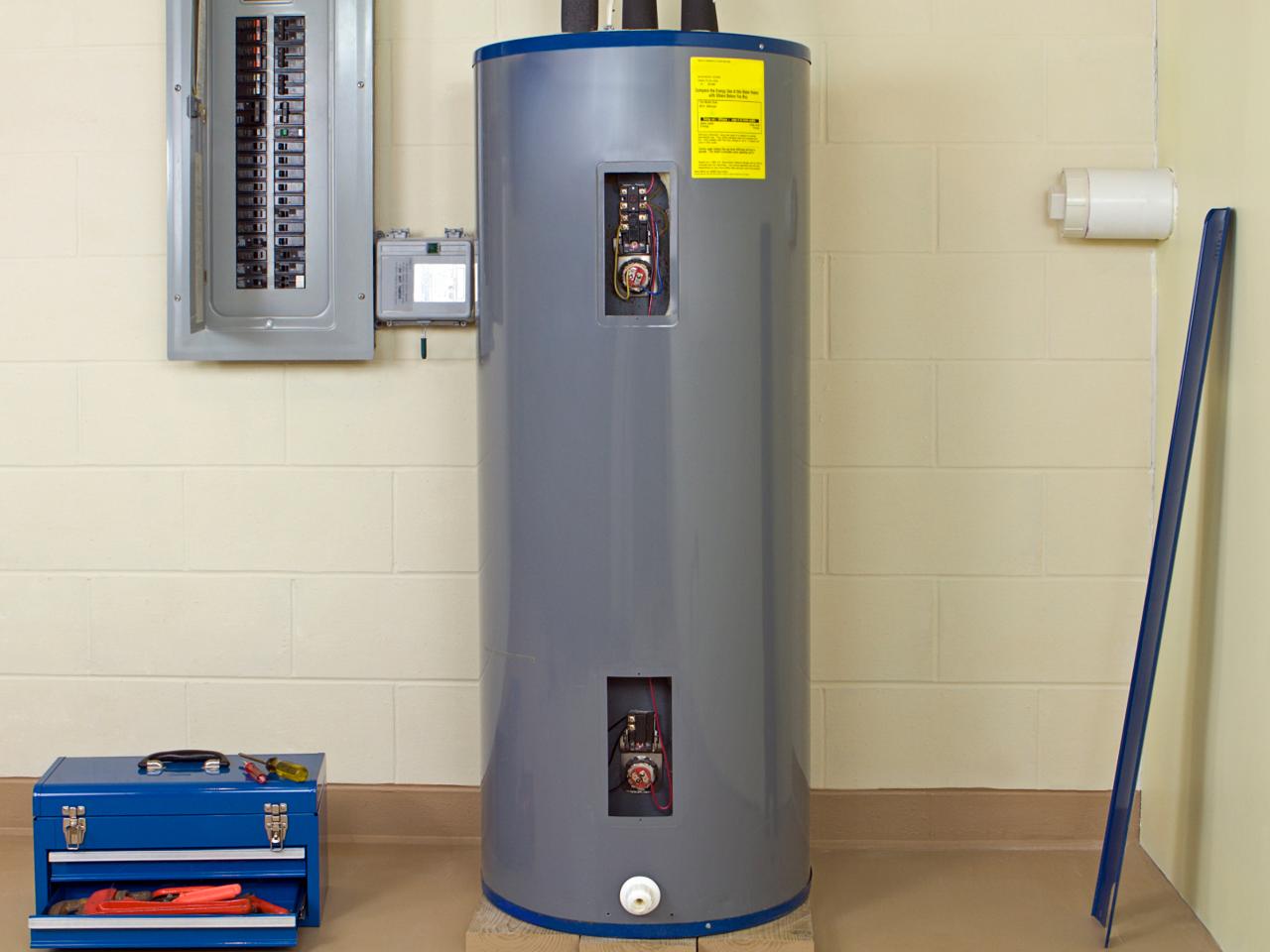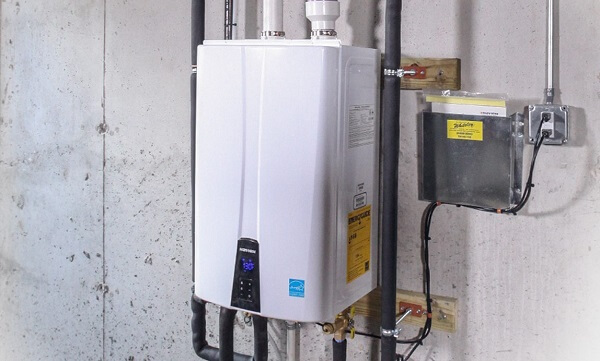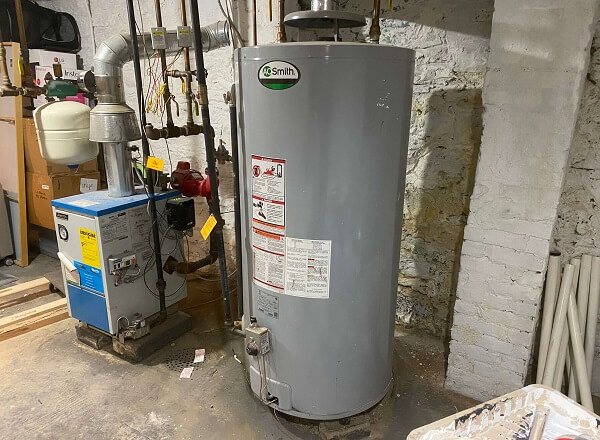What is a hot water tank?
A hot water tank (also known as a hot water heater) is exactly what it sounds: a large tank designed to heat and hold water. The tank draws cold water from the home’s water supply system, heats it, and distributes it to sinks, bathtubs, and dishwashers.
There are several types of hot water tank, which use different methods and fuels to heat the water. Gas heaters (fuelled by natural gas or propane) are the most popular, but electricity, oil and solar-powered tanks are also available. Most tanks hold around 200 litres of water.
How do hot water tanks work?
A hot water tank is a simple device: a big cylindrical water tank with a heating element inside.
The tank mostly metal, with a protective liner inside to prevent corrosion. There’s also a layer of insulation to prevent heat loss. Combustion-style heaters (oil or gas) have an exhaust vent much like a car does. Older models might even have a chimney.
Cold water enters the tank near the top, then makes its way via the dip tube to the bottom, where heats it to the target temperature set by the thermostat. The heated water rises to the top of the tank, where it enters the home’s hot water pipes.
Types of hot water tanks
Storage tank water heater
The tank-style water heater is the most common variety in Canada. They’re probably what you imagine when you think of a hot water heater. Tank water heaters can be as small as 85 litres in a 1-2-person home or surpass 200 litres in a large home with 5 or more residents. Most models use electricity, propane, or natural gas as their fuel.

The main drawback of storage tank water heaters is that they expend energy keeping water hot around the clock, even during long periods where they’re not in use (like overnight).
Tankless hot water heater
True to their name, the tankless hot water heater doesn’t have a tank in which to store water. Instead, they heat water on-demand. They’re much smaller than tank-style models, and more energy efficient as well. Tankless water heaters are reliable and long-lasting, too. We’ve got a whole article on tankless water heaters if you’d like to read about those.
The downsides? They’re more expensive than tank-style heaters, and may not be able to output enough water for peak usage (like running the dishwasher while someone’s having a shower).

Heat pump hot water heater
Though they are tank-like in appearance, heat pump hot water heaters have one big difference from a typical tank heater: they use electricity to draw in heat from the surrounding air and use it to heat the water, rather than heating the water directly. They’re like the opposite of a refrigerator, which pumps heat out rather than in. These are highly efficient devices, using as much as 60% less electricity than a typical hot water tank.
Unfortunately, they aren’t well-suited to chilly basements where water heaters often live; the less ambient heat they have to work with, the less efficiently they run. They’re also rather expensive, though the energy cost savings can make up for that in short order.

How to choose a hot water tank and heater?
Decide what fuel source your hot water tank will use
The fuel source is one of the principal factors in determining how efficient your tank will be (and how much it will cost you to run). Most people choose the fuel source that’s already set up in their home.
For example, if your home has a natural gas connection ready to go, you’d choose a natural gas heater. If you don’t have a gas system, it makes sense to buy an electric heater rather than set up a gas line and venting.
It’s also important to consider utility costs in your area. Natural gas is often much cheaper than electricity. So, while a gas heater costs more up front, it might end up paying for itself in the long run.
Here are the pros and cons for hot water tanks of the most common fuel types:
Electric
- Pros: Easy to install and operate, lower upfront cost, high energy efficiency, safer than gas
- Cons: Higher utility costs, slow to heat, won’t work during a power outage
Natural gas
- Pros: Quick-heating, low utility costs, can work during power outage
- Cons: More expensive up front, harder to install (needs gas lines and venting), potential safety issues with flammable gas
Propane
- Pros: Same as natural gas, but propane burns cleaner as well
- Cons: Same as natural gas
Figure out how much hot water capacity you need
If your tank is undersized, it will overwork itself and often run out of water. An oversized tank, on the other hand, will use more energy than necessary.
There are two ways to measure a hot water tank’s capacity: the physical capacity of the tank itself, and the unit’s First Hour Rating, or FHR. The FHR is a measure of how much hot water the unit can output in one hour, starting with a full tank of fully heated water.
Estimate your water usage during the busiest hour in your home. It’s often in the morning, before work, as everyone in the family showers. It could also be in the evening, while drawing a bath and running the dishwasher. With a high-end estimate, you can decide if a hot water tank’s FHR is high enough.
To add up your peak hourly usage takes a little math, but it paints a clear picture of your hot water needs.
Here are some estimated hot water usage rates for common activities:
| Activity |
Water usage |
| Hot water faucet |
3.8 litres / minute (1 gallon / minute) |
| Typical shower |
7.6 litres / minute (2 gallons / minute) |
| Dishwasher |
9.5 litres / minute (2.5 gallons / minute) |
Appliances and plumbing fixtures often have their water usage rates printed on them (or at least in a manual somewhere).
If you want to choose a new tank based on total capacity, you can estimate what you’ll need based on how many people live in the house and how many bathrooms and appliances you have:
| Home description |
Tank capacity |
| 2 people, 1 bathroom |
90-135 litres (24-36 gallons) |
| 2-3 people, 2 bathrooms |
135-180 litres (36-48 gallons) |
| 3-4 people, 3 bathrooms |
180-225 litres (48-59 gallons) |
| 4-5 people, 2-3 bathrooms, plus dishwasher and laundry |
180-290 litres (48-77 gallons) |
| 5+ people, 3+ bathrooms, frequently-used dishwasher and laundry |
290-540 litres (77-143 gallons) |
If you have high-efficiency appliances and you know your family takes short showers, you can work with the lower end of the range. If you take frequent hot baths and have old, inefficient appliances, you might need something at the higher end.
As you can see, choosing a model based on total capacity is a little imprecise. It’s more effective to calculate your hot water needs using the FHR if you can.
Costs of hot water tanks
On average, buying and installing a hot water tank costs between $1,000 and $1,300.
The larger a tank is, the more it costs (unsurprisingly). Gas-fuelled models cost more than electric ones.
To buy a tank on its own, expect to pay between $700 and $1,000 for an electric tank or between $1,000 and $2,000 for a gas model. There are models priced outside these ranges, but for an average home that’s about where you should set your expectations.
If you need to have a professional install your tank, expect to pay an added $100-500, depending on how much work needs to be done.
If you’re wondering where to buy a hot water tank, you can do so from virtually any large hardware store, or a plumbing/heating company. Most businesses that sell hot water tanks can also install them for you. Many will also give you a free estimate and give you advice on the right size and model before you buy.
What should you do when your hot water tank is not working?
Here are some of the most common issues with hot water tanks and what you can do to address them:
No hot water
The most common cause of a gas-fired tank not putting out hot water is a failed pilot light. The pilot light is a small flame inside the device that’s always lit and serves as an ignition source for the main burner. If the pilot light goes out, your burner can’t heat any water. Check further down the page for instructions on re-lighting the pilot.
Another possible reason your hot water tank isn’t hot is a damaged or disconnected dip tube. The dip tube is inside the tank and sends the cold water to the bottom of the tank. A broken dip tube means cold water is sitting at the top of the tank and not being heated before entering the plumbing system.
Not enough hot water
If your hot water runs out prematurely, your heater may be too small. As a reference, check the sizing guidelines in the last section, or read Natural Resources Canada’s hot water tank guide for in-depth information on tank sizing.
The tank is leaking
Leaking is often a symptom of a serious problem that requires professional help. If you notice water around your tank, first shut off the fuel source and then the cold-water supply. Reliance Home Plumbing and City Wide Water Heater Service both have videos showing you how to do this. Then, get in touch with a serviceperson.
There’s a hissing noise coming from the tank
This could mean that the liner inside the tank has corroded or cracked, and water is leaking. You may not see any water on the ground, as the leaking water is boiling and turning to steam (hence the hissing sound). If you hear hissing from your hot water tank, get a professional to take a look.
There’s a boiling sound coming from the tank
Also known as “kettling” (like water boiling in a kettle), boiling sounds from your tank are often caused by water bubbling through sediment at the bottom of the tank. You might also hear kettling sounds if your tank is overheating the water. A faulty thermostat or other mechanical issue is often to blame. Regardless, you should speak to a professional if you hear boiling sounds — and ensure that the unit’s pressure release valve is working.





